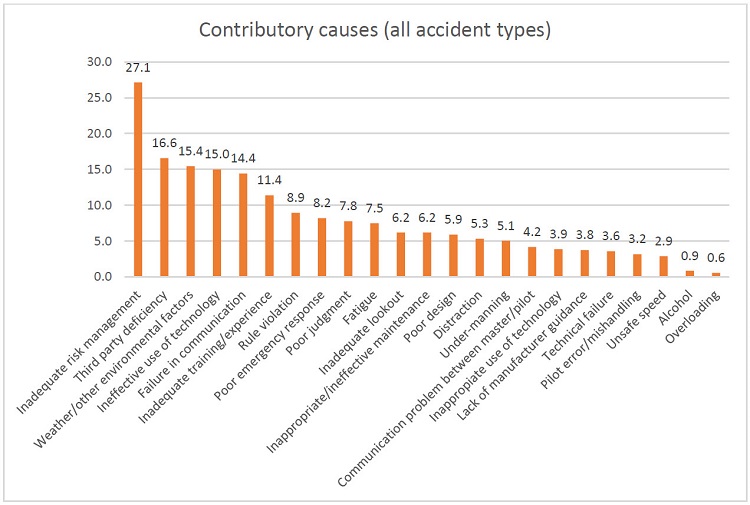Accident Analysis: Action Needed on Recruitment and Training
An analysis of shipping accidents between 2002 and 2016 has highlighted recruitment and training issues as a key factor that the industry should address.
The study was conducted by researchers from the Seafarers International Research Centre of Cardiff University in the U.K and involved analysis of 693 accident investigation reports published on line by the U.K. Marine Accident Investigation Branch (MAIB), the Australian Transport Safety Bureau (ATSB), the National Transportation Safety Board (NTSB), the Federal Bureau of Maritime Casualty Investigation in Germany and the Danish Maritime Accident Investigation Board (DMAIB).
The most common type of accident was “collision, close quarters and contact” (35.8 percent), followed by grounding (17 percent), fire and explosion (9.8 percent) and lifeboats (3.3 percent).
The analysis highlighted failure of risk management systems, for example inadequate passage planning, and failure in communication as issues relevant to recruitment and training. “It is often not possible to discern the underlying causes of communication failure,” state the study authors. “In some incidents information is simply not passed on and in others there may be language or hierarchical barriers at play. This is an area where better training and recruitment practices would be expected to have a positive impact providing the industry with a constructive way forward with regard to accident mitigation.”
Where poor judgment is identified as a factor, the study authors believe that better training or more careful selection procedures could serve to reduce accidents in the future. Better training could also help prevent accidents involving ineffective use of technology, rule violation, ineffective maintenance and poor emergency response.
Third party deficiencies were also a common accident cause, including, for example, pilot error and poor design. “It is arguably the case that the focus by regulators and enforcement agents on third party deficiencies has been inadequate, to date, and that this needs urgent rectification,” state the study authors.
The analysis also indicates areas where shore-based managers need to place greater priority on safety and less emphasis on commercial considerations (e.g. with regard to weather routing, crewing, loading and ensuring that equipment manuals are readily available in appropriate languages on board).

Credit: The causes of maritime accidents in the period 2002-2016 by Acejo, I., Sampson, H., Turgo, N., Ellis, N., Tang, L. (November 2018)
Collisions
The most common immediate causes of “collision, close quarters and contact” accidents were inadequate lookout (24.6 percent of cases), failure in communication (15.3 percent), poor judgment (14.1 percent), and pilot error (12.9 percent). Ineffective use of technology was commonly identified by investigators and found to be a contributory cause in 24.2 percent of cases.
Groundings
Failures in communication and coordination were the most common immediate cause in groundings (16.1 percent of cases), followed by inadequate lookout (11.9 percent), poor judgment (11 percent), fatigue (9.3 percent) and technical failure (8.5 percent). Third party causes of grounding such as pilot error were identified in 6.8 percent of cases.
Lifeboat accidents
The most common immediate cause of lifeboat accidents was “inappropriate/ineffective maintenance” (26.1 percent of cases), inadequate training and experience (21.7 percent), poor design (17.4 percent) and poor judgment (13 percent).
Fire and explosion accidents
Inadequate risk management was the main immediate cause of fire and explosion incidents (27.3 percent of cases), followed by third party deficiency (18.2 percent), technical failure (18.2 percent) and inappropriate/ineffective maintenance (16.7 percent).
